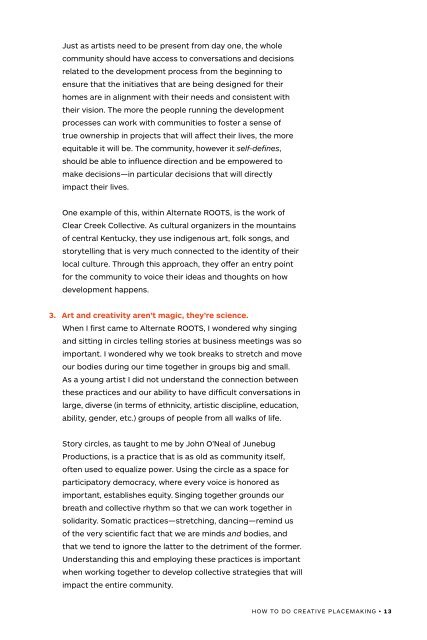placemaking
8myXe6Hx8
8myXe6Hx8
Create successful ePaper yourself
Turn your PDF publications into a flip-book with our unique Google optimized e-Paper software.
Just as artists need to be present from day one, the whole<br />
community should have access to conversations and decisions<br />
related to the development process from the beginning to<br />
ensure that the initiatives that are being designed for their<br />
homes are in alignment with their needs and consistent with<br />
their vision. The more the people running the development<br />
processes can work with communities to foster a sense of<br />
true ownership in projects that will affect their lives, the more<br />
equitable it will be. The community, however it self-defines,<br />
should be able to influence direction and be empowered to<br />
make decisions—in particular decisions that will directly<br />
impact their lives.<br />
One example of this, within Alternate ROOTS, is the work of<br />
Clear Creek Collective. As cultural organizers in the mountains<br />
of central Kentucky, they use indigenous art, folk songs, and<br />
storytelling that is very much connected to the identity of their<br />
local culture. Through this approach, they offer an entry point<br />
for the community to voice their ideas and thoughts on how<br />
development happens.<br />
3. Art and creativity aren’t magic, they’re science.<br />
When I first came to Alternate ROOTS, I wondered why singing<br />
and sitting in circles telling stories at business meetings was so<br />
important. I wondered why we took breaks to stretch and move<br />
our bodies during our time together in groups big and small.<br />
As a young artist I did not understand the connection between<br />
these practices and our ability to have difficult conversations in<br />
large, diverse (in terms of ethnicity, artistic discipline, education,<br />
ability, gender, etc.) groups of people from all walks of life.<br />
Story circles, as taught to me by John O’Neal of Junebug<br />
Productions, is a practice that is as old as community itself,<br />
often used to equalize power. Using the circle as a space for<br />
participatory democracy, where every voice is honored as<br />
important, establishes equity. Singing together grounds our<br />
breath and collective rhythm so that we can work together in<br />
solidarity. Somatic practices—stretching, dancing—remind us<br />
of the very scientific fact that we are minds and bodies, and<br />
that we tend to ignore the latter to the detriment of the former.<br />
Understanding this and employing these practices is important<br />
when working together to develop collective strategies that will<br />
impact the entire community.<br />
HOW TO DO CREATIVE PLACEMAKING • 13


